- About us
- Support the Gallery
- Venue hire
- Publications
- Research library
- Organisation chart
- Employment
- Contact us
- Make a booking
- Onsite programs
- Online programs
- School visit information
- Learning resources
- Little Darlings
- Professional learning
In his practice, Wiradjuri artist Brook Andrew explores and interrogates colonialism, race and power, recasting and dismantling Western historical narratives. A descendant of the Yiman and Bidjara nations of Queensland, Professor Marcia Langton AO (b. 1951) is an anthropologist, geographer and academic. A preeminent voice in First Nations discourse and advocacy, Langton examines the colonialism and racism underlying social, political and cultural structures in Australia. Andrew’s portrait of Langton is an assemblage of 15 individual screen-printed components. He placed Langton in a seated pose referring to her interest in Buddhism, developed while living in Asia in the early 1970s. The black and white zig-zagging lines, which reference the dendroglyphs traditionally carved into trees on Wiradjuri Country, radiate out in a river-like flow of energy. Against a colonial history of collecting human remains in this country, the skulls held by Langton are reclaimed, pointing to her work in political and legal anthropology. The diamond sun alludes to the sitter’s work with First Nations communities, native title claims and mining companies.
Commissioned with funds provided by Marilyn Darling AC 2009
© Brook Andrew
Marcia Langton by Brook Andrew created in 2009. A huge and complex screenprint on paper incorporating a variety of different printing techniques, the elements cut out and collaged, overlapping in places. It is 252 by 242 cm with a simple narrow wooden frame.
Marcia Langton, a descendant of the Yiman and Bidjara nations of Queensland, an academic and activist, is depicted life-size, dynamic and powerful, sitting cross-legged on the ground with three pairs of arms radiating from her shoulders. She is simultaneously real and magical. The flattened perspective, bold colours and crisply defined shapes and patterns in the background contrast with the fuzzy out-of-focus monochrome tones of her figure.
The background is divided neatly into two sections. The upper half is white paper with a perfectly formed circle suspended high up in the centre. The circle is approximately 40 cm in diameter, filled with a brilliant yellow and orange faceted pattern that resembles a sparkling gemstone. The bottom half of the matt background is pitch black, running across is an irregular black and white zigzagging shape. The pattern, based on the Wiradjuri nation’s motif of a diamond – stretched and squeezed, distorted and repeated – pulses like a river of energy.
Reaching toward the circle in the upper half of the picture is a pair of Marcia’s arms, hands wide open, palms out, streaked in vivid red, black and light-tan. Her head, positioned between her two raised arms, tilts dramatically to the left side, disjointed from the torso. Her shoulder-length shock of wavy white and grey hair frames her entire face, extending under her chin and around her throat like an Elizabethan collar.
She has a long oval face, broad forehead and dark complexion. Thick black eyebrows arch over her large dark eyes. She gazes out. Below her long straight nose, full Kewpie doll lips, pursed, and pressed in at the edges, reveal the faint glimmer of a smile.
Another pair of her arms reach out horizontally from the shoulders, one to each side, elbows bent, the right arm held higher than the left, streaked with royal blue, black and light-tan. Each wrist hinges downwards, fingertips clutching the cranium of a skull; a black skull in her right hand, a white skull in her left. The skulls look out, jaws ajar, animated with sketchily drawn red features.
Marcia’s pear-shaped body sits cross-legged on the ground wrapped in blurry bands of darkness and light, a shadowy shawl of blurred Wiradjuri diamond pattern falls softly over the left side of her chest and arm. A deliberate vertical length of pale bronze colour streams down her body and crossed legs.
A third pair of arms hang gently at her sides, elbows bent, each hand resting on a knee. Her right hand positioned palm up, glows brilliant yellow. A small swirling shape of flickering orange levitates above it. The left hand and wrist, positioned palm down, appear disconnected from the shadowy blackness around her waist, like a brilliant yellow disembodied gauntlet.
Starting at her knees, her shins and feet merge into a seamless curve, meeting in a wide point, balancing her figure in the centre and anchoring it to the bottom edge of the picture.
Audio description written by Marina Neilson and voiced by Krysia Kitch
Brook Andrew (age 39 in 2009)
Trent Walter (age 29 in 2009)
Professor Marcia Langton AO (age 58 in 2009)
Marilyn Darling AC (33 portraits supported)
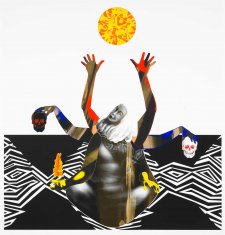
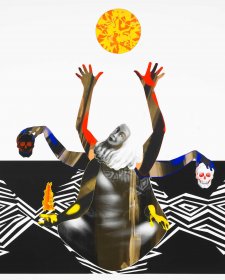
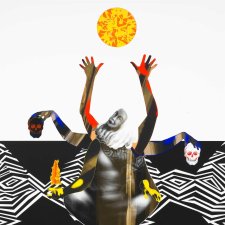
Join us for an interactive, curriculum-aligned program that explores the lives and contributions of significant Australians.



On one level The Companion talks about the most famous and frontline Australians, but on another it tells us about ourselves.
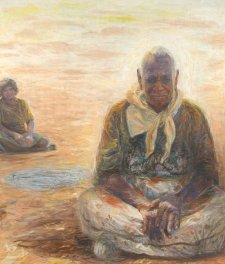
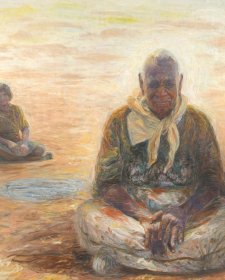
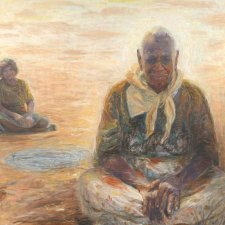
Joanna Gilmour reflects on 25 years of collecting at the National Portrait Gallery.